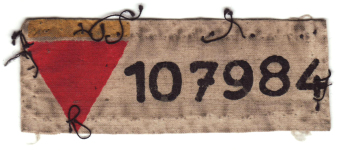Prisoner Number

© United States Holocaust Memorial Museum (Wollheim papers)
Only those deportees who were not selected at arrival in Auschwitz for immediate murder in the gas chambers were registered and assigned numbers by the SS. Each inmate received a consecutive number by which he/she henceforth was managed and addressed in the camp, rather than by name. There were separate series of numbers for men and women; later on there were also series for special categories of prisoners, such as the Z numbers for inmates admitted to the “Gypsy camp” of Birkenau after February 26, 1943, or the R numbers up to 11957, given to Russian prisoners of war after October 7, 1941.
For men in Auschwitz, there were three series: the general series of numbers from 1 to 202499, used to register inmates from May 1940 until January 18, 1945; the A series, used for 20,000 prisoners from May to August 1944; and the B series, for 14,479 prisoners in the period from July 31 to early November 1944. The A and B series were introduced after May 1944 for so-called transport Jews, whom the Reich Security Main Office ordered to be brought to Auschwitz. Since the early days of the Auschwitz concentration camp, the prisoners had been marked with numbers on their clothing. After mid-1942, Jewish prisoners received a tattooed prisoner number on their left forearms. From 1943 on, all inmates who were not Reichsdeutsche were tattooed. Only in Auschwitz were the numbers tattooed on the prisoners; in other concentration camps, the prisoners’ numbers only had to be worn on their clothing.
In addition to the tattoing, clothing at the Buna/Monowitz concentration camp was marked with two cloth badges about 4 cm wide and 12 cm long, which the prisoners had to sew onto the left breast of their jackets and the right legs of their trousers at pocket level. Besides the number, these cloth strips displayed a triangle indicating the prisoner’s Haftgrund (reason for arrest). The combination of triangle and prisoner number enabled the SS, as well as experienced inmates, to quickly size up a prisoner’s situation and hence frequently gauge his or her chances of survival as well.
The height of the number showed how long a prisoner had been in the camp and perhaps where he or she came from. The inmates in the Buna external work detachment, including David Rosenbaum (number 44124), who was deported to Auschwitz in June 1942, still had “low” numbers. In the Buna/Monowitz concentration camp, the first prisoners, who came there in October 1942 from Buchenwald, Sachsenhausen, and other camps of the “Old Empire,” had numbers between 67000 and 69000. Fritz Löhner-Beda, for example, had 68561. By March 1943, when the Norwegian Jews, including Julius Paltiel (105362), and the last Berlin Jews, among whom was Norbert Wollheim (107984), were deported to Auschwitz, the numbers already ranged from 104530 to 112107. In April 1943, the SS deported the huge Jewish community of Thessaloniki (Salonika), Greece, to Auschwitz, including Ya’acov Handeli (115003) with his parents and siblings. In September 1943, many French Jews, among them Victor “Young” Perez (157178) from Drancy, were deported to the Buna/Monowitz concentration camp. At the same time, the SS began liquidating the ghettos in Poland, such as Tarnów, from which Herbert Kalter (161306) was deported to Buna/Monowitz in November 1943, as well as the ghettos in the Baltic. Thus, also in November 1943, the brothers Albert (160761) and Max Kimmelstiel (160762) were brought to Auschwitz from Riga, to which the SS had deported them, along with their parents, in December 1941. Over the course of a few weeks in summer 1944, the SS deported 500,000 Jews from Hungary and Hungarian-occupied regions to Auschwitz. Among those arriving in the Buna/Monowitz concentration camp in May 1944 were Aleksandar Ribner (186967), from the Hungarian-occupied Voivodina, and Benjamin Grünfeld (A-8979), from the Hungarian-occupied part of Romania. As the Red Army advanced, the SS began to liquidate the remaining ghettos in the late summer of 1944, including Kielce, from which Alexander Feingold (B-3005) was deported in August 1944. The inmates of the forced-labor camps in eastern Poland, too, were transported to Auschwitz. One of them was Marcel Ginzig (B-4961) from Ostrowiec near Kielce, who was assigned to the Buna/Monowitz concentration camp.
(MN; transl. KL)
















